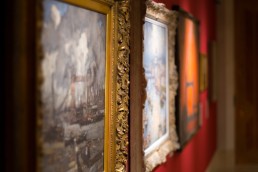
Preserve and Protect
Will Salter, Senior Designer at dpa lighting consultants discusses the importance of designing lighting for museums that preserves the artefacts on display, as well as enhancing the visitor experience.
The purpose of museums and galleries is to collect, preserve and display objects of cultural, artistic, or scientific significance for the education of the public. However, finding a balance between the two key objectives; display and preservation, is often hard to achieve.
This is because when a decision is made to exhibit an object it may be detrimental to its visual and physical integrity, cause ageing or fading of its materials or impact the significance or value of the piece. Therefore, it is imperative to understand the environment of the space the object will be displayed in, so that it can be exhibited under ‘safe’ gallery conditions while optimising the visitor experience.
Lighting is essential and plays a crucial role. A considered lighting scheme helps to create an atmosphere that complements the artwork, making it more engaging and immersive for visitors. Additionally, lighting can be used to highlight specific aspects of the artwork, such as colour, texture, and detail, making it easier for visitors to appreciate and understand the work.
Today, great thought and consideration is given to elements such as humidity, temperature, air quality and lighting to create a suitable environment for displaying objects to the public. Each has its own set of guidelines that museums follow during the installation and then continue to monitor during the entire time objects are on display.
The current lighting conservation guidelines for sensitive artifacts groups display objects in to three categories. These are: Sensitive Collections (works on paper, photographs, textiles) 50 lux max; Less Sensitive Collections (oil paintings, wood, leather) 150 lux max; Least Sensitive Collections (metal, ceramics, stone, glass) 300 lux.
Currently, there is an assumption that when the museum opens, the lights turn on and when the museum closes, they turn off. This means, for the most part, that the artwork on display is lit to the same lux level all day, every day – and then sometimes for longer due to out of hours events and viewings.
Display objects are assigned annual light exposure levels. An example of how this is measured is by calculating the usual opening hours of a museum, seven hours a day for six days a week over 52 weeks, therefore resulting that an item can be exposed to light 2,184 hours a year. This figure is then multiplied by the recommended light intensity to give the lux hours. So, a sensitive item with a maximum of 50 lux will have a rough total of 100,000 lux hours.
Some institutions have already started to rethink their approach to object rotation to reduce the total time of exposure to light. These include rotating items from storage or turning pages of books or manuscripts on display.
The most effective strategy in reducing light damage is to reduce illuminance and time of exposure. The longer you leave an item exposed to light, the more damage it will do.
An example of this is at The Edvard Munch Museum in Oslo, where there is an installation displaying three versions of ‘The Scream’: a painting, a print, and a drawing. To protect the works only one is displayed at any one time, whilst the other two are covered. It is programmed to automatically rotate hourly to reduce exposure (lux hours) to each piece whilst creating a sense of mystery and intrigue at the same time.
A similar approach should become more widely adopted in museums because when implemented in this way it does not only benefit the artwork but also the visitor.
Using lighting control systems linked to sensors and timers will reduce total exposure time as the display object will only be illuminated when someone is in the gallery or viewing the display object. Turning off or dimming luminaires that are illuminating artworks will also reduce the energy consumption of galleries throughout the show, therefore not only protecting the works but also resulting in lower energy consumption.
Another benefit from the advances in lighting control technology is the use of digital controls, such as smartphones, tablets, and computers, to manage lighting systems remotely. This allows lighting designers to adjust lighting levels and colours from anywhere, making it possible to tailor lighting to specific needs and preferences. Also, it allows curators or gallery assistants to recall pre-programmed scenes that could, for example, raise the light level on a particular artwork whilst giving a talk or tour.
Perhaps with the recent technological improvements within the lighting industry, such as the seamless incorporation of digital motion sensors, timers, and in particular smart control systems, a case can be made to encourage museums to begin to adopt such elements. Along with the move away from halogen light sources, is it now time for the lighting conservation guidelines for sensitive artifacts to be re-written?



